Client: Bachelor Thesis Project (BTP)
Guide:Dr. Prasad Bokil
INTRODUCTION
Analogy-based design (ABD) means applying analogy to a design situation. In this project, process of analogical transfer of concepts/ syntax of Carnatic classical music to obtain the rules of shape grammar and its applications is demonstrated.The musical properties, including rhythm, texture, tone, melody, harmony, style, and tempo which give essence to the composition of music are taken as source for rules to build same properties among shapes through rules of shape grammar.
In this project, the rules of the element of carnatic music ‘Talam‘ are jotted and implemented in Grids. Similarly, the rules of the element- ‘Swaras’ is implemented in Colors and together forming a grammar representing a compositon in Carnatic Music.
LAYAPRASTHARA
‘laya‘ means rythm and ‘prastara‘ means tabular representation.
This book is the outcome of the final year academic project. This is the book which explains and demonstrates the principles of converting the structure of an Talam - element of carnatic music into visual grids. The grids of Tisra- Rupaka talam have been used in the book as a part of application. The grids emerged from ‘Talam‘ in carnatic music can be explored further for various applications in graphic design.
‘laya‘ means rythm and ‘prastara‘ means tabular representation.
This book is the outcome of the final year academic project. This is the book which explains and demonstrates the principles of converting the structure of an Talam - element of carnatic music into visual grids. The grids of Tisra- Rupaka talam have been used in the book as a part of application. The grids emerged from ‘Talam‘ in carnatic music can be explored further for various applications in graphic design.
ANALOGY BASED DESIGN:
Analogy-based design (ABD) means the application of analogy to design. The ABD is used not only for the normal traditional design, but also for the innovative and creative design. Analogy is nothing but comparison between two things, based on their form or function. Gentner’s (1983) Structure-Mapping Theory supports the view that an analogy can be characterized as the application of a system of major structural relations from a source, to the problem to be solved.
Holyoak (1990), maintains that analogical mapping is triggered when a source analog presents a solution procedure that seems to be more efficient than a rule of inference. In this theory, structural principles are considered as secondary, and mapping is directed by the importance of the predicates as regards the goals at hand. Thus, the goals of the target largely control the mapping process.
Holyoak (1990), maintains that analogical mapping is triggered when a source analog presents a solution procedure that seems to be more efficient than a rule of inference. In this theory, structural principles are considered as secondary, and mapping is directed by the importance of the predicates as regards the goals at hand. Thus, the goals of the target largely control the mapping process.

Methodology Followed:
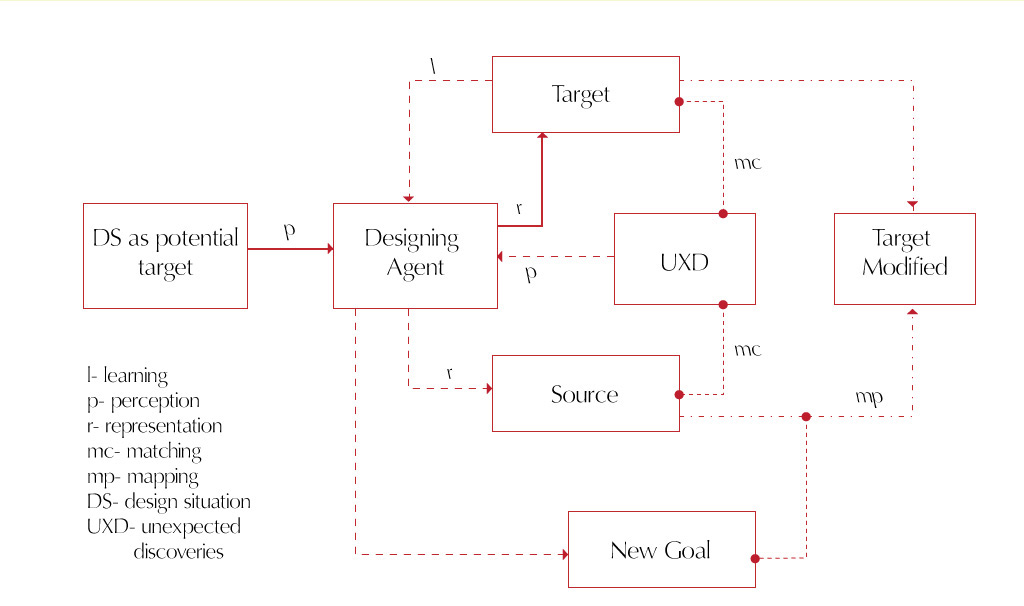
Talam to Grids
SOURCE:
Carnatic Music
Carnatic music is a system of music commonly associated with the southern part of the Indian subcontinent, with its area roughly confined to four modern states of India: Andhra Pradesh, Karnataka, Kerala, and Tamil Nadu
The four basic elements of carnatic music:
Sruti, Swara, Raga , Talam
Carnatic music is a system of music commonly associated with the southern part of the Indian subcontinent, with its area roughly confined to four modern states of India: Andhra Pradesh, Karnataka, Kerala, and Tamil Nadu
The four basic elements of carnatic music:
Sruti, Swara, Raga , Talam
TARGET:
Shape Grammar
A shape grammar is a set of shape rules that apply in a step-by-step way to generate a set, or language, of designs. Shape grammars are both descriptive and generative. The rules of a shape grammar generate or compute designs, and the rules themselves are descriptions of the forms of the generated designs.
A shape grammar is a set of shape rules that apply in a step-by-step way to generate a set, or language, of designs. Shape grammars are both descriptive and generative. The rules of a shape grammar generate or compute designs, and the rules themselves are descriptions of the forms of the generated designs.
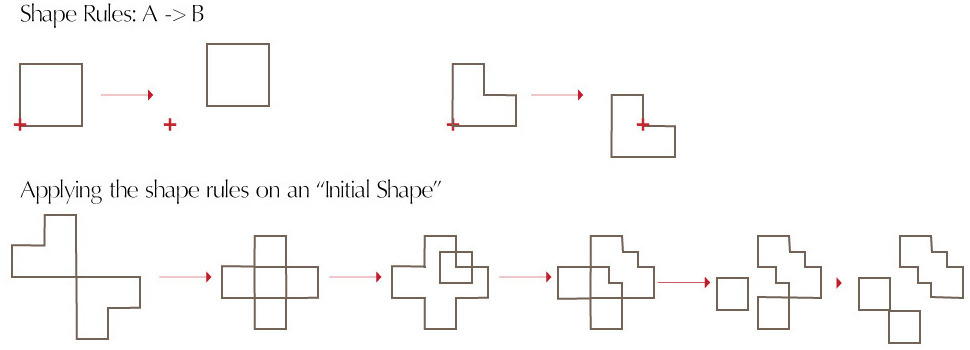
In the process of drawing the elements and categorisation with respect to functionalities and behaviour of the elements of carnatic music (Source) to form ‘Rules’, jotting down of mathematical ranges and rhythmic varieties of Talam was done.
Insisting on the analogy of the source and target, this can brief therelation and selection of both the topics:
Syntax of Talam : Carnatic Music :: Shape Grammar: Designs
Exploring the relations and possibilities to represent a kind of talam in the grid system by dividing a fixed “space into the divisions to represent the time”
Syntax of Talam : Carnatic Music :: Shape Grammar: Designs
Exploring the relations and possibilities to represent a kind of talam in the grid system by dividing a fixed “space into the divisions to represent the time”
Talam:
Element of Carnatic Music: TALAM
The rhythmic cycle. It is a set of beats that is repeated throughout the rendition of the composition.
Tala is formed with three basic parts (called Angas): Angam means a limb, unit, or art a thaalam
Laghu(I): Tap of the hand on the lap and counting the fingers. This can take the values of 3,4,5,7,9 beats.
Dhrutam(O): Tap on the lap and a wave. This can take 2 beats.
Anudhrtam(U): Tap on the lap. This can take 1 beat.
The rhythmic cycle. It is a set of beats that is repeated throughout the rendition of the composition.
Tala is formed with three basic parts (called Angas): Angam means a limb, unit, or art a thaalam
Laghu(I): Tap of the hand on the lap and counting the fingers. This can take the values of 3,4,5,7,9 beats.
Dhrutam(O): Tap on the lap and a wave. This can take 2 beats.
Anudhrtam(U): Tap on the lap. This can take 1 beat.
Types of talam:
Druva Talam (I O I I)
Matya Talam (I O I)
Rupaka Talam (O I)
Jampa Talam (I U O)
Triputa Talam (I O O)
Ata Talam (I I O O)
Eka Talam (I)
Matya Talam (I O I)
Rupaka Talam (O I)
Jampa Talam (I U O)
Triputa Talam (I O O)
Ata Talam (I I O O)
Eka Talam (I)
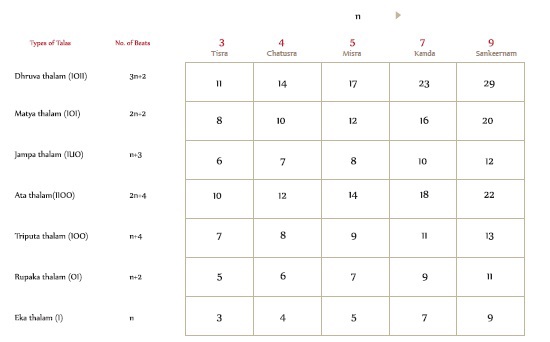

RULES OF TALAM:
These are the rules that will be converted to the selected kind of design that is 'grids'.
1)Talam is composed of set or sequences of beats (x)
2)All the beats occur at a equal interval / periods of the time (t).
3)Beats are grouped in 1,2,3,4,5,7,9 periods.
4)No talam starts with an anudrutham.
5)No talam ends with an anudrutham.
6)Most of the talams start with laghu (Except for rupak)
7)There are 7 types of talams
8)The types of talam are defined with different combinations of laghu,drutham and anudrutham.
9)There are 5 kinds of Laghus.
10)Kinds of laghus are grouped as 3,4,5,7,9 beats
2)All the beats occur at a equal interval / periods of the time (t).
3)Beats are grouped in 1,2,3,4,5,7,9 periods.
4)No talam starts with an anudrutham.
5)No talam ends with an anudrutham.
6)Most of the talams start with laghu (Except for rupak)
7)There are 7 types of talams
8)The types of talam are defined with different combinations of laghu,drutham and anudrutham.
9)There are 5 kinds of Laghus.
10)Kinds of laghus are grouped as 3,4,5,7,9 beats
GRID REPRESENTATIONS:
These ‘Rules of Talam‘ are converted to represent in the form of grids.
Each section has clear explanation of a kind of talam in the
five Possibilities of grids :
1)Number of columns = number of beats, Without Gutter Space
2)Number of columns = number of grouped beats, Without Gutter Space
3)Number of columns = number of grouped beats, With Gutter Space
4)Number of columns = number of grouped beats, With Gutter Space of importance of one beat
5)Number of columns = number of beats with group-based Gutter Space
Each section has clear explanation of a kind of talam in the
five Possibilities of grids :
1)Number of columns = number of beats, Without Gutter Space
2)Number of columns = number of grouped beats, Without Gutter Space
3)Number of columns = number of grouped beats, With Gutter Space
4)Number of columns = number of grouped beats, With Gutter Space of importance of one beat
5)Number of columns = number of beats with group-based Gutter Space
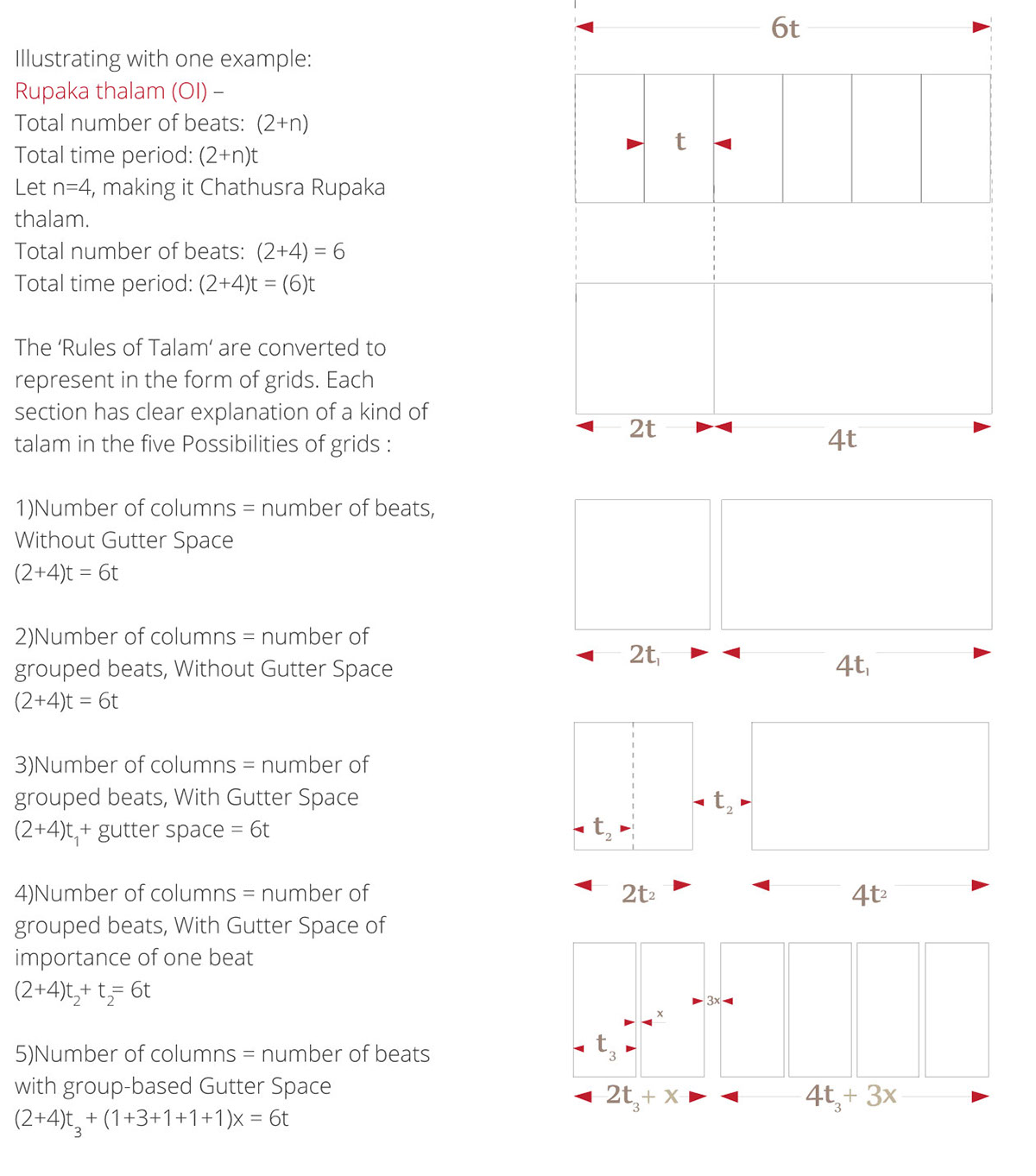
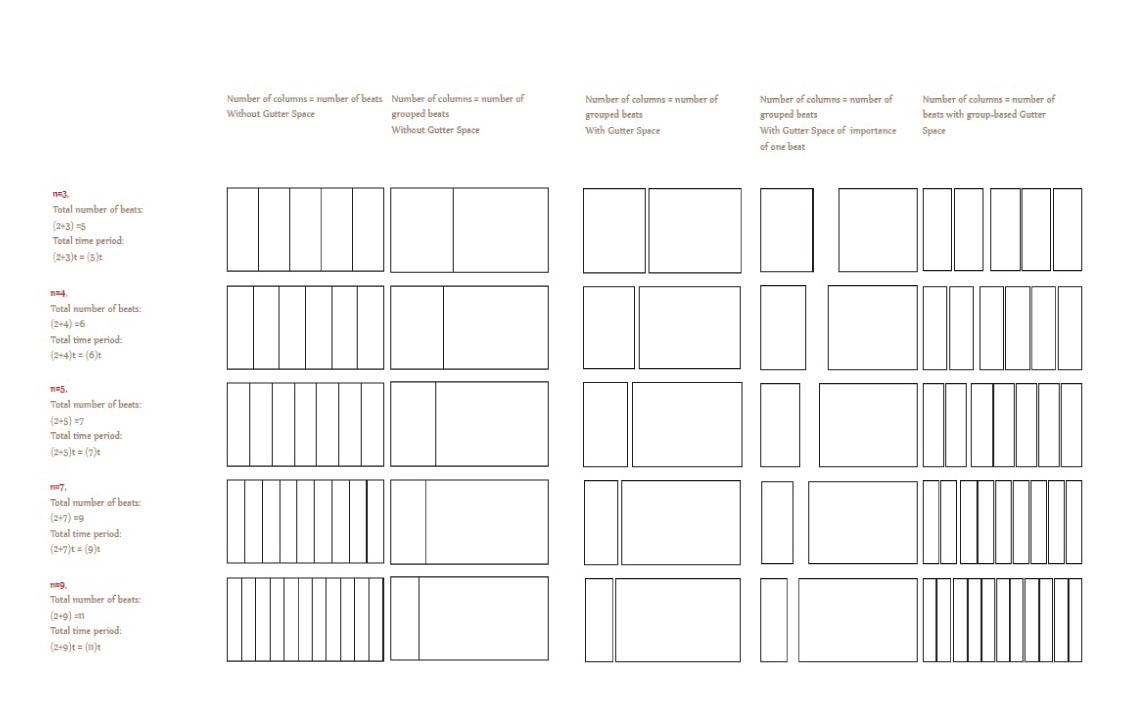
Rupak Talam Grid Examples
Similar to this , all the seven kinds of talam grids were represented according to the jotted possibilities.
Next step of analogy similar to this was to represent swaras in color (Converting sound frequency to light frequency) and illustrated various songs to know the patterns in a composition of a song using grids structure to represent talam.

For example- further details can be provided on contacting.
FUTURE DIRECTIONS:
Using the outcomes of the basis/ foundation, the following can be done:
1) Plugins can be created for design softwares for readymade grids with user-guide defining every style of the grids for easy selection of suitable grid w.r.t the content.
2)Toolkit can be created for learning carnatic music visually for better retention of the concepts and making notes in the grids for clear understanding of structure of a composition similar to a drawing kit that children might be interested in.
3)Repetitive patterns can be figured out in the composition for better understanding of Ragams and their properties, for faster recognition of particular ragam.
4)Basics/foundations for creating language for a system for/of real-time visualisations during a concert.
5)Visualisation Grammar that can be used to understand the structure of carnatic music just using basic elements of design(basic shapes and colors) by novice either during a concert or learning sessions.
BOOK DESIGN
Layaprasthara is an outcome of the final year acdemic project.
The whole book except for the sections of the talam is designed in grid of ‘Tisra- Rupak Talam‘. Every section of the talam was designed in a particluar grid related to that talam as mentioned on the landing page of respective sections. The grids used in the process are : Chatusra- Rupak talam, Tisra-Triputa talam, Chatusra- Ata talam, Tisra- Matya talam, Chatusra- Jampa talam, Tisra- Dhruva talam and Chatusra- Eka talam.
Out of the 5 varieties of the grids jotted before, the fifth possibility- “Number of columns = number of beats with group-based Gutter Space” is used. These grids are illustrated on the oil paper attached in front of each section.
Typefaces Used:
Nyala (Regular) for body text
Marcellus (Regular) for headings
BOOK PRINTING

Sample printing on normal white paper for proper dimensioning
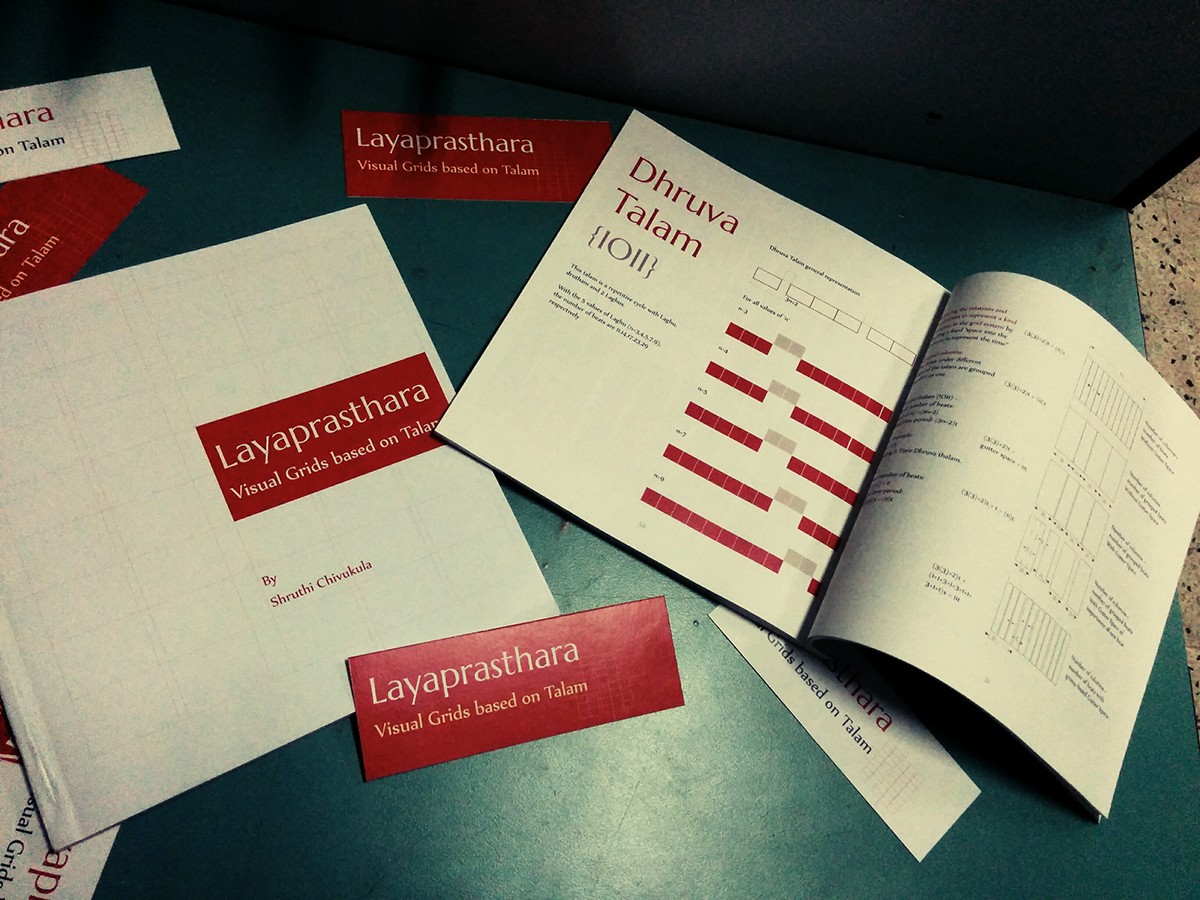
Final Book

Final Book and some bookmarks

